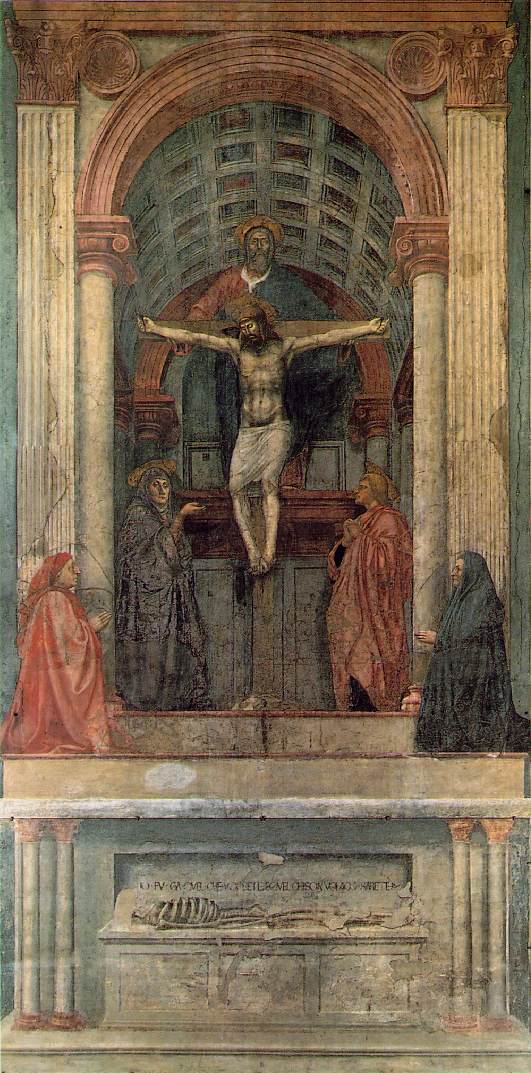- Holy Trinity (Masaccio)
Infobox Painting|

title=The Holy Trinity
artist=Masaccio
year=1428
type=fresco
height=667
width=317
museum=Santa Maria Novella, Florence"The Holy Trinity, with the Virgin and Saint John and donors" ( _it. Santa Trinità) is a famous
fresco by the EarlyItalian Renaissance painterMasaccio . It is located in the church ofSanta Maria Novella , inFlorence .This is the most celebrated work of Masaccio beside the frescoes in the
Brancacci Chapel . Opinions vary as to exactly when this fresco was painted between 1425 and 1428. It was rediscovered in its entirety in 1861, after being hidden in the sixteenth century by a Vasari altarpiece and a stone altar.The work was taken up by nineteenth-century critics as a revelation of
Brunelleschi 's principles in architecture and the use of perspective, to the point that some believed Brunelleschi to have had a direct hand in the design of the work. When it was executed, no actual cofferedbarrel vault had yet been constructed. [Siegfried Giedion, in "Space, Time and Architecture", points out that the first would beLeon Battista Alberti 's interior and external barrel vaults at Sant'Andrea, Mantua, begun nearly five decades after Masaccio's premature death.]The "Trinity" is noteworthy for its inspiration taken from ancient Roman
triumphal arch es and the strict adherence to the recent perspective discoveries, with avanishing point at the viewer's eye level, so that, as Vasari describes it ["Levite ...":"Masaccio"] "a barrel vault drawn in perspective, and divided into squares with rosettes which diminish and are foreshortened so well that there seems to be a hole in the wall." This artistic technique is called trompe l'oeil which means, "deceives the eye," in French. The fresco had a transforming effect on generations of Florentine painters and visiting artists. The sole figure without a fully-realized three-dimensional occupation of space is the majestic God supporting the Cross, considered an immeasurable being. The figures of the two patrons [the patrons are identified as members of the Lenzi family or, more recently, Berto di Bartolomeo del Bandeario and his wife] represent another important novelty, occupying the viewer's own space, in front of the picture plane, which is represented by the Ionic columns and the pilasters from which the feigned vault appears to spring; they are depicted in the traditional prayerful pose ofdonor portrait s, but in natural size and with a noteworthy attention for realism and volume.The most likely interpretation of the "Trinity" is that the painting links the traditional medieval connection of the chapel with Golgotha the "place of the skull" where Christ died, with the patrons' or Adam's tomb in the lower part and the Crucifixion in the upper part. But it can also assume the significance of the journey the human spirit must undertake to reach salvation, rising from the earthly life and corruptible body through prayer (the two petitioners and patrons) and the intercession of the Virgin and Saint John the Evangelist to the Trinity.
A close-up view of the skeleton in the sarcophagus also revealed the ancient warning, in clear letters: I WAS WHAT YOU ARE AND WHAT I AM YOU SHALL BE.
Notes
Further reading
*Goffen, Rona. "Masaccio's 'Trinity" (series "Masterpieces of Western Painting")
External links
* [http://www.humanitiesweb.org/human.php?s=g&p=a&a=i&ID=381 HumanitiesWeb: Masaccio's "Trinity"]
Wikimedia Foundation. 2010.
